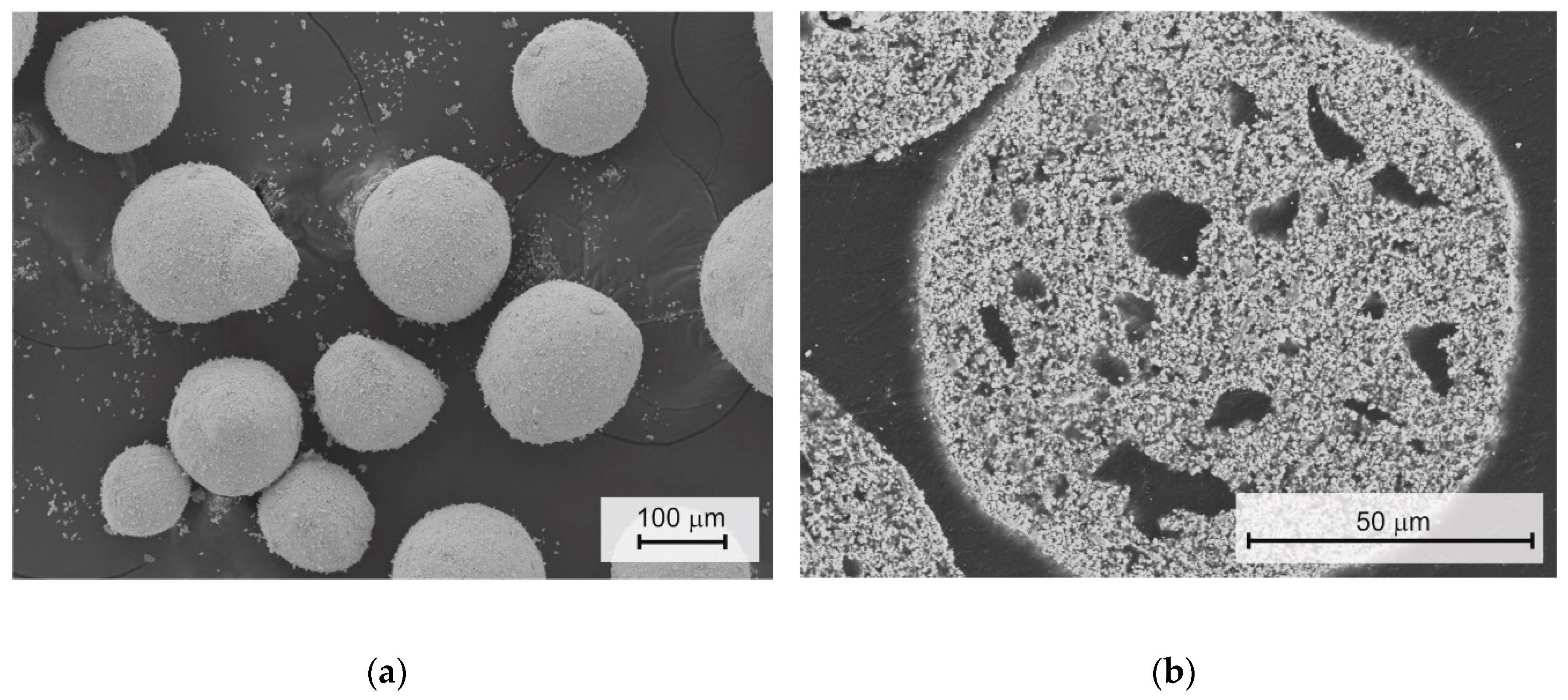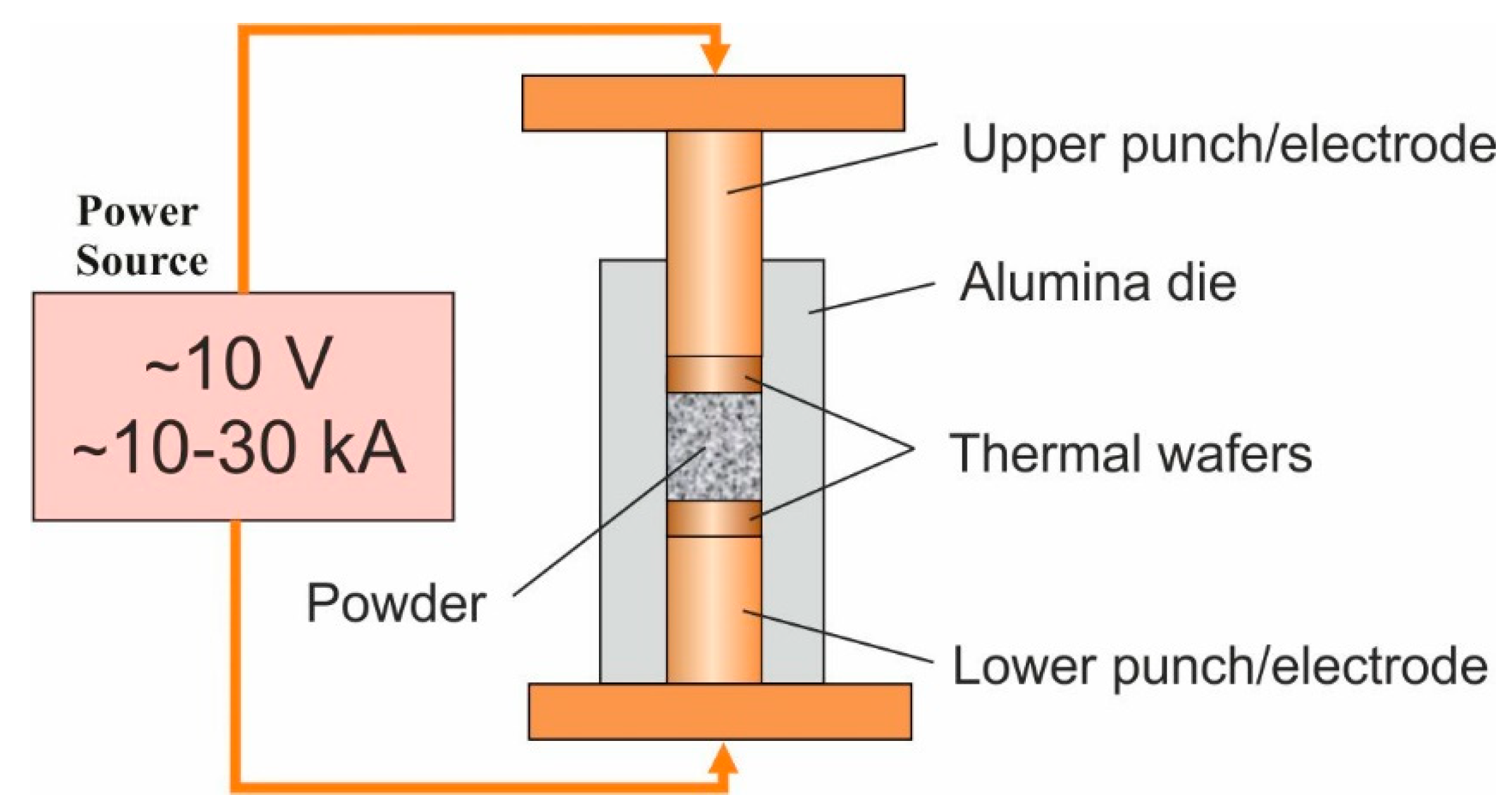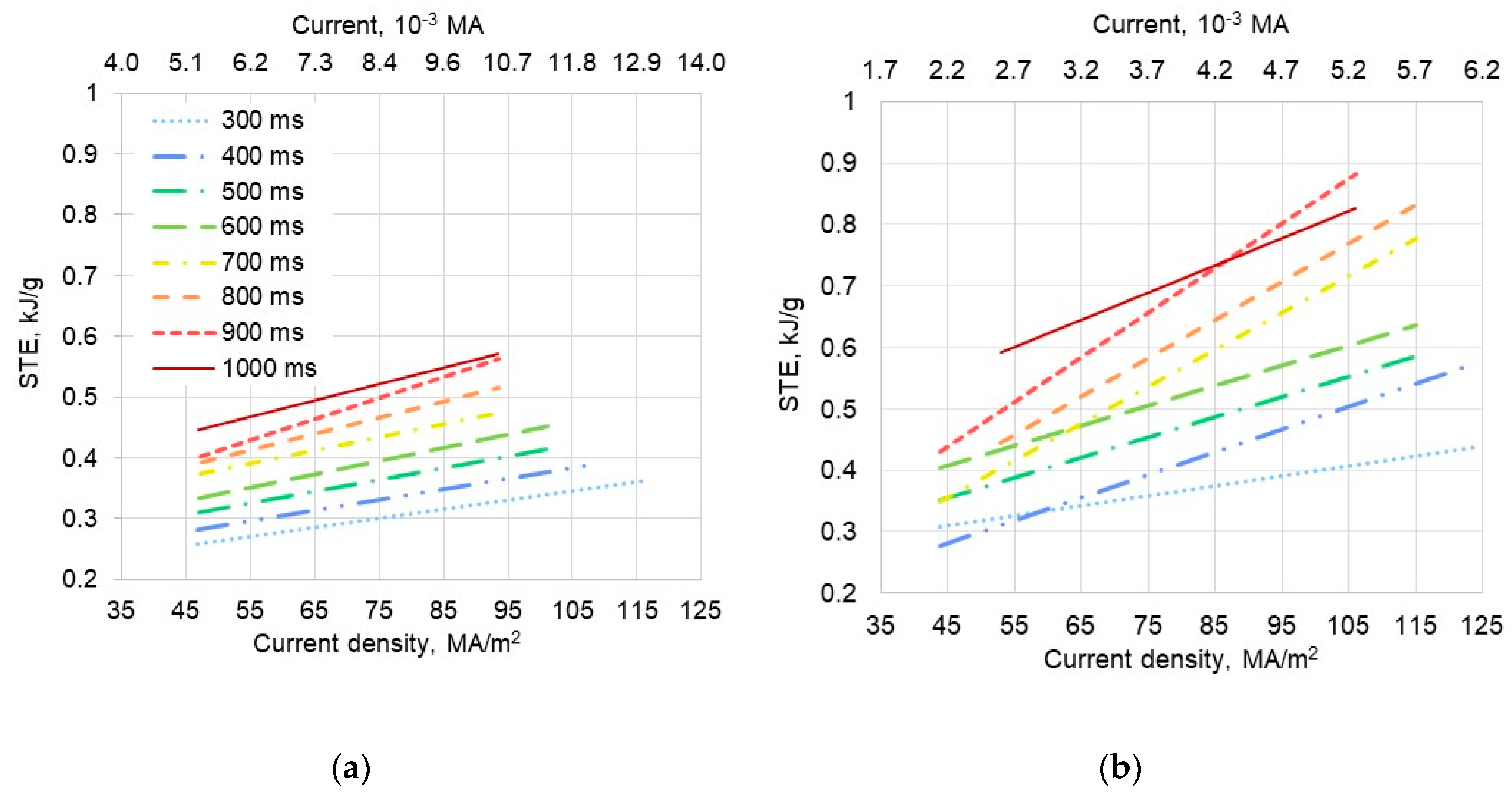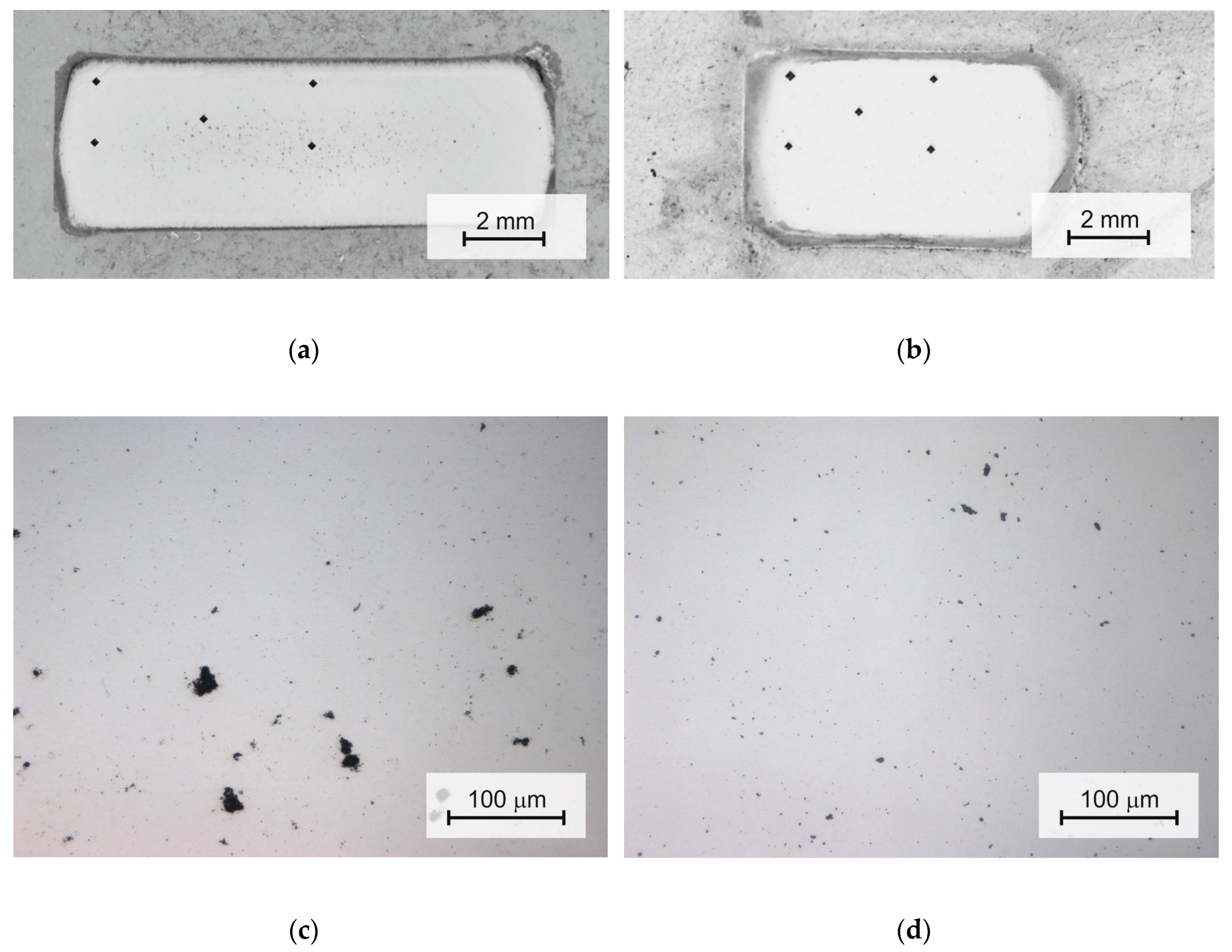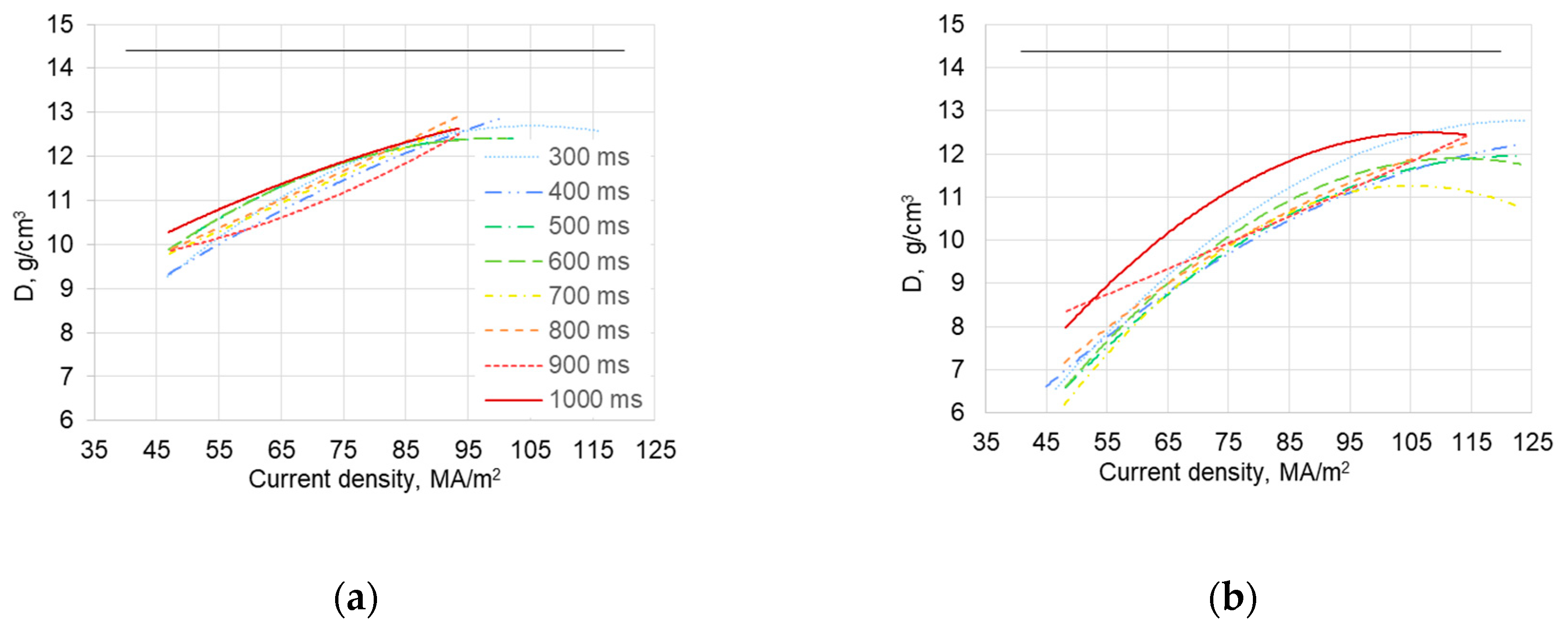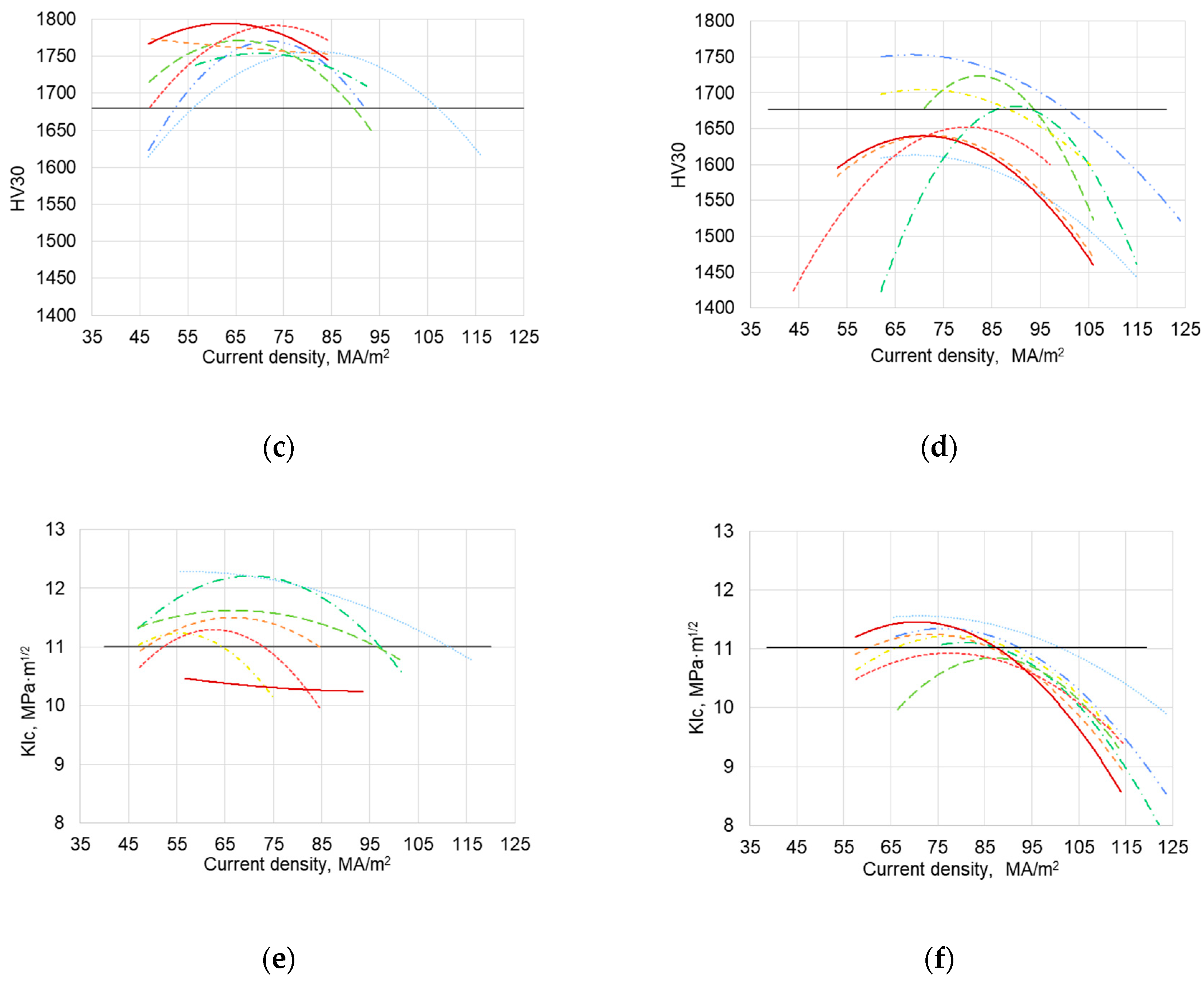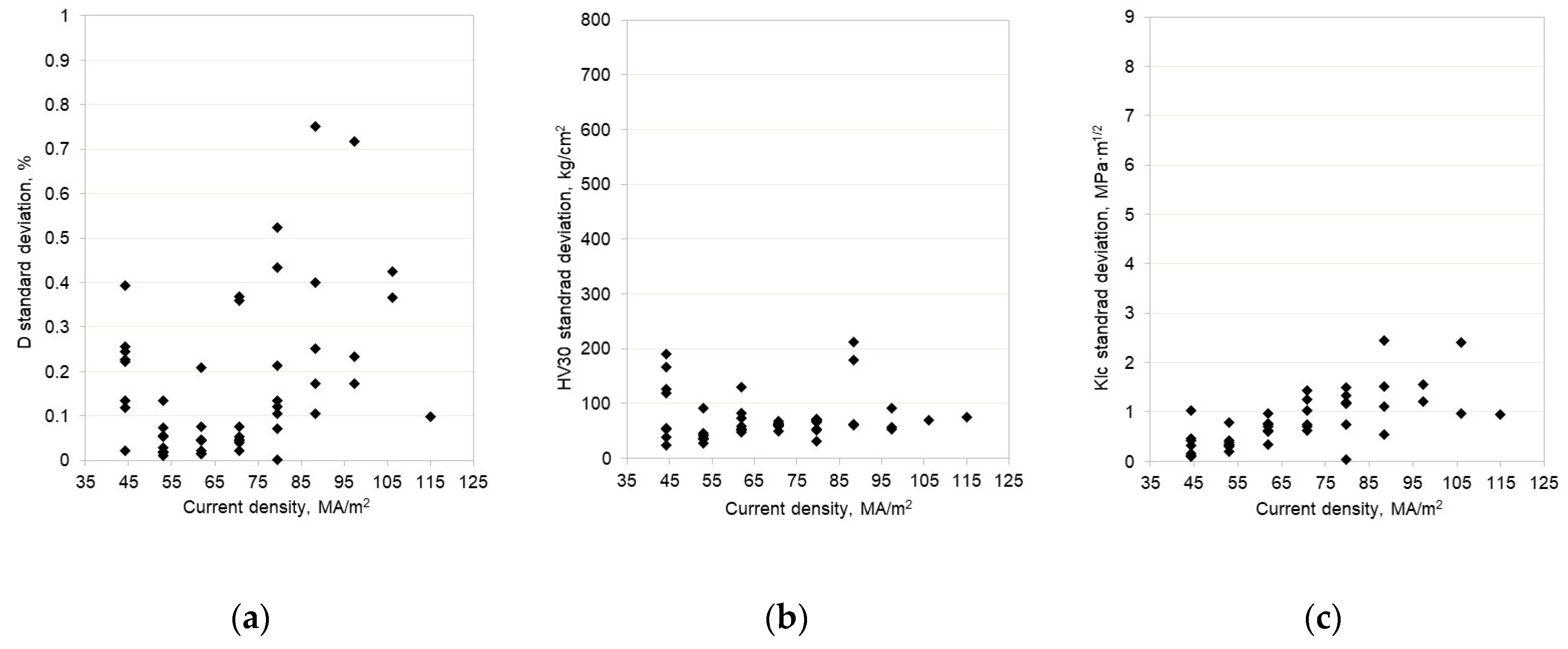1. Introduction
Parts produced from powders commonly use the cold pressing and sintering conventional procedure [
1], because of its simplicity and lower cost. Nevertheless, the powder metallurgy (PM) industry incorporates a wide variety of different procedures, depending on the specific features of the component to be produced, or the material to be processed [
2]. In this context, directly using electricity as a method to sinter powders (both metals and ceramics) has been suggested and tested historically [
3], generally without a consistent theoretical base. This technology was developed to the exploration stage between 1906 and 1960. Pure direct current resistance sintering, or mixed capacitor discharge and transformers, were initially explored [
4,
5,
6]. From 1960 to 1990, after studies by Inoue [
7] concerning the use of different current waveforms, the development stage was reached. Recently, the technology has entered the exploitation stage, with an exponential increase of publications, patents, and applications [
8].
The acronym FAST (field-assisted sintering techniques) is usually applied to PM techniques in which electricity is directly used to perform the sintering of the powders [
3]. Indeed, the term FAST is very appropriate, as a short production time is the most remarkable characteristic among these techniques. Consolidation cycle lengths in FAST methods are extremely short, compared to the conventional PM methods. Additionally, short-lasting processes can limit structural evolution. In this way, nanostructures, or even glassy materials [
9], can be processed.
Three main criteria can be used to classify FAST methods: (a) The power source nature, (b) the process duration, and (c) the electrical nature (conductor or insulating) of the die containing the powders. Three FAST processes stand out, from more than 30 variants described in the literature [
10,
11]: Capacitor Discharge Consolidation (CDC), Spark Plasma Sintering (SPS), and Electrical Resistance Sintering (ERS).
The CDC process uses the energy stored in a capacitor bank to consolidate the powders. Current is discharged through the powder (which may be under compression), acting as electrical resistance. The bank electrical capacitance and the charging voltage (up to the order of kV) dictate the energy amount of the process. The discharge takes place between a micro and a millisecond, with peak current values of the order of kA. Current flows only through the electrically conductive powders, due to the insulating nature of the dies. Sintering is usually attributed to microwelds between the powder particles, as powder and die heating is limited [
12,
13].
Some similarities occur between the SPS and ERS processes, concerning power supply. Both of them can use a welding transformer as power source. However, the dwelling times of SPS are longer (in the order of minutes). Consequently, a protective inert or vacuum environment is usually needed for SPS. Heat is mainly produced in the SPS electrically-conductive die, normally made of graphite. Therefore, the powders do not necessarily have to be conductive. It is still debated whether plasma between the particles develops during the process, despite the common name given to the process [
14,
15,
16].
ERS usually complements the plain-welding transformer current supply with medium-frequency power electronics, thus reducing the transformer size. Voltage, typically 10 V, and current, between 10–30 kA, are maintained during the whole period of the process, which is typically on the order of a second. As the dies are electrically insulating, the powders must be conductors. Heating by the Joule effect softens the powder mass, which is simultaneously subjected to pressure [
17]. At the same time, secondary processes occur in the powder: Surface oxide removal, electromigration, and electroplasticity.
The hard metal or cemented carbides industry [
18,
19] can clearly benefit from FAST processes. In addition, the market revenue is high enough as to justify the necessary exploitation stage development. Nevertheless, it is important to understand the difficulties associated with these processes. Non-linear, coupled interactions between several system properties, as well as between the densification process and the geometry of the system, occur during the consolidation process. As a general picture, increasing pressures reduce green (as-pressed) porosity, but not homogeneously in the powder mass. Density unevenness produced when applying pressure will be magnified by the process. On applying a current, the resistance and Joule heat produced will be higher in high-porosity areas. Conversely, denser green zones will increase density at a slower pace. To understand the final properties, it is also important to consider the electrical and thermal conductivity dependences on temperature. Even though the ERS process is extremely quick, temperatures can increase to near or above the melting temperature. Specific heat capacity will also vary, due to phase transformations during heating. Heat losses, through die walls and pressing punches, may contribute to microstructural inhomogeneities. Die and punch thermal conductivities are, indeed, very important [
20].
Therefore, it is of great interest to know the exact effect of every process variable on the final product properties. In this paper, a general review of the effect of process variables is carried out on the ERS of WC + 10 wt.% Co hard metals.
2. Materials and Methods
Premixed WC + 10 wt.% Co (WC10Co) powders, supplied by several producers, were tested to select the most adequate to be processed by ERS. The main properties to be tested were particle size distribution, flow rate, compressibility, electrical resistivity vs. applied pressure, carbon content, and dissolved gases. A balance of ample flow rate, high compressibility, and a relatively low electrical conductivity were considered, a priori, as the target properties of the powder mass. Another important property was the thermal conductivity of the powder mass. It is well known, for other systems [
21], that ERS consolidation is dramatically affected by such properties. Kyocera Unimerco (Denmark) was selected as the powder supplier for this study. The selected WC10Co powder was degassed (840 °C/0.75 h/N
2H
2) to minimize problems due to gas expulsion during processing, and presintered (1100 °C/2 h/Ar) in order to increase particle size and facilitate flow rate for further processing. Final particles consisted of spherical agglomerates (
Figure 1), some of them consisting of an external layer, with the inner being partially empty. The final powder had an ultrafine WC grain size of around 300 nm.
Table 1 shows the main properties of the selected powder. LECO combustion analysis was used to measure the C and O content.
The experimental ERS sintering equipment employed (Beta 214 MF, Serra Soldadura, Barcelona, Spain) is sketched in
Figure 2. A weighed amount of powder, as to produce a full dense compact 4 mm thick, was fed into the electrically insulating die and vibrated to achieve its tap density [
22]. Two cylindrical dense alumina dies, with 8 and 12 mm nominal inner diameters, respectively, were used for the experiments. Graphite powder in acetone suspension was used as die wall lubrication. High purity copper punches, lined with Cu-W wafers on the powder contact surface, were employed.
The first step of the ERS process was to apply a uniaxial, single effect pressure through an electrically driven actuator with a maximum force capacity of 10 kN and a top travel speed of 100 mm/s. In this work, two pressures were tested, namely, 100 MPa (12 mm diameter die) and 250 MPa (8 mm diameter die). Typical travel speeds were of 50 mm/s.
The power source was regulated through a computer controlled inverter. An electrical current wave was applied in the form of a 10 MHz square pulse, direct current. After some trials to avoid experimental problems (mainly welding between powders and wafers and die durability), current densities (up to 125 MA/m
2) and sintering times (between 300 ms and 1000 ms) were tested. Pressure was applied for 1000 ms before allowing current passing, and was released 1000 ms after current get-off to allow for compact cooling. A typical cycle, as measured by the equipment sensors, is shown in
Figure 3. As shown, the initial shrinkage of the powders due to current passage cannot be followed by the punch, and a pressure drop was measured, being slowly recovered. On the other hand, intensity requires a certain time to reach the target value, due to this transitory period (of about 100 ms) where the current control algorithm is unable to fix the set value.
Final compact density was measured in the as-sintered compact, as per the Archimedean method and by weighing and measuring the cylindrical samples. Archimedean density was calculated by the differential weighing method, in air and then after maintaining the sample in boiling water for 1 h, as described in the well-accepted ISO Standards [
23]. Samples were axially sectioned, and then prepared by proper grinding with up to 400 grit SiC paper and polishing with 6 and 3 micrometer diamond paste. When needed, an Epiphot 200 (Nikon, Tokyo, Japan) metallographic light microscope (LM) was used. The Vickers HV30 hardness, with a high enough load to give a mean hardness value of carbides and cobalt, was measured on a Duramin-A300 (Struers GmbH, Willich, Germany), according to ISO Standards [
24]. Porosity was measured through image analysis (software Image Pro Plus 6, Media Cybernetics Inc., Rockville, MD, USA) on scanning electron microscopy (SEM, model Teneo, FEI, Eindhoven, The Netherlands) images, accomplished by appropriate metallographic preparation and according to ISO Standards [
25]. Finally, toughness (using the Palmqvist method, ISO Standards [
26]) was also measured, after a precisely-shaped crack was produced by the indentation method. Those properties were assessed at five points in the sectioned sample, according to the pattern shown in
Figure 4. These points were always sufficiently away from the outer porous layer surrounding the sintered specimen. Finally, this outer porous layer was characterized, using the ratio of the dense core height to the total height of the sample.
Author Contributions
Conceptualization, J.M.G. and J.M.M.; methodology, Y.T. and F.G.C.; validation, R.A., T.S., and J.C.; writing—original draft preparation, J.M.G. and I.A.; writing—review and editing, F.G.C. and J.C.
Funding
This research was funded by EU, grant number FoF.NMP.2013-10 608729 (7th Framework Programme) EFFIPRO.
Conflicts of Interest
The authors declare no conflict of interest. The funders had no role in the design of the study; in the collection, analyses, or interpretation of data; in the writing of the manuscript, or in the decision to publish the results.
References
- Cintas, J.; Montes, J.M.; Cuevas, F.G.; Gallardo, J.M. Influence of PCA content on mechanical properties of sintered MA aluminium. Mater. Sci. Forum 2006, 514–516, 1279–1283. [Google Scholar] [CrossRef]
- Gundermann, P. Overview of the status and trends in the European PM industry. Cfi Ceram. Forum Int. 2018, 95, E21–E25. [Google Scholar]
- Olevski, E.; Dudina, D. Field-Assisted Sintering: Science and Applications; Springer: Cham, Switzerland, 2018. [Google Scholar]
- Lux, J. An Improved Manufacture of Electric Incandescent Lamp Filaments from Tungsten or Molybdenum or an Alloy Thereof. GB Patent No. 27,002, 13 December 1906. [Google Scholar]
- Duval D’Adrian, A.L. Article of Fused Metallic Oxide and Process of Producing the Same. U.S. Patent 1,430,724, 3 October 1922. [Google Scholar]
- Taylor, G.F. Apparatus for Making Hard Metal Compositions. U.S. Patent No. 1,896,854, 7 February 1933. [Google Scholar]
- Inoue, K. Electric-Discharge Sintering. US Patent 3,241,956, 22 March 1966. [Google Scholar]
- Grasso, S.; Sakka, Y.; Maizza, G. Electric current activated/assisted sintering (ECAS): A review of patents 1906–2008. Sci. Technol. Adv. Mater. 2009, 10, 053001. [Google Scholar] [CrossRef] [PubMed]
- Maurya, R.S.; Sahu, A.; Laha, T. Effect of consolidation pressure on phase evolution during sintering of mechanically alloyed Al86Ni8Y6 amorphous powders via spark plasma sintering. Mater. Sci. Eng. A 2016, 649, 48–56. [Google Scholar] [CrossRef]
- Saheb, N.; Iqbal, Z.; Khalil, A.; Hakeem, A.S.; Aqeeli, N.A.; Laoui, T.; Al-Qutub, A.; Kirchner, R. Spark Plasma Sintering of Metals and Metal Matrix Nanocomposites: A Review. J. Nanomater. 2012, 2012, 983470. [Google Scholar] [CrossRef]
- Chunping, Z.; Kaifeng, Z. Pulse Current Auxiliary Sintering. In Sintering Applications; Ertuğ, B., Ed.; InTech: Rijeka, Croatia, 2013. [Google Scholar]
- Grigoryev, E.G.; Olevsky, E.A. Thermal processes during high-voltage electric discharge consolidation of powder materials. Scr. Mater. 2012, 66, 662–665. [Google Scholar] [CrossRef]
- Romero, E.; Montes, J.M.; Cintas, J.; Cuevas, F.G. Electrical discharge consolidation with stud welding technology. In Proceedings of the Materials Science and Technology Conference and Exhibition 2013, Montreal, QC, Canada, 27–31 October 2013; Volume 3, pp. 1737–1744. [Google Scholar]
- Guillon, O.; Gonzalez-Julian, J.; Dargatz, B.; Kessel, T.; Schierning, G.; Räthel, J.; Herrmann, M. Field-assisted sintering technology/spark plasma sintering: Mechanisms, materials, and technology developments. Adv. Eng. Mater. 2014, 16, 830–849. [Google Scholar] [CrossRef]
- Marder, R.; Estournès, C.; Chevallier, G.; Chaim, R. Spark and plasma in spark plasma sintering of rigid ceramic nanoparticles: A model system of YAG. J. Eur. Ceram. Soc. 2015, 35, 211–218. [Google Scholar] [CrossRef]
- Saunders, T.; Grasso, S.; Reece, M.J. Plasma formation during electric discharge (50 V) through conductive powder compacts. J. Eur. Ceram. Soc. 2014, 35, 871–877. [Google Scholar] [CrossRef]
- Montes, J.M.; Cintas, J.; Cuevas, F.G.; Ternero, F. Método para la Fabricación Pulvimetalúrgica de Imanes. Patent No. ES2543652 (WO 2015/101682 A1), 23 February 2016. [Google Scholar]
- Norgren, S.; García, J.; Blomqvistb, A.; Yin, L. Trends in the P/M hard metal industry. Int. J. Refract. Met. Hard Mater. 2015, 48, 31–45. [Google Scholar] [CrossRef]
- Global Tungsten Carbide Market—Analysis & Forecast, 2017–2022. Research and Markets, ID: 4176295. 2017. Available online: https://www.researchandmarkets.com/reports/4176295/global-tungsten-carbide-market-analysis-and (accessed on 1 December 2018).
- Montes, J.M.; Rodriguez, J.A.; Cuevas, F.G.; Cintas, J. Consolidation by Electrical Resistance Sintering of Ti Powder. J. Mater. Sci. 2011, 46, 5197–5207. [Google Scholar] [CrossRef]
- Montes, J.M.; Cuevas, F.G.; Ternero, F.; Astacio, R.; Caballero, E.S.; Cintas, J. Medium-Frequency Electrical Resistance Sintering of Oxidized C.P. Iron Powder. Metals 2018, 8, 426. [Google Scholar] [CrossRef]
- MPIF Standard 46, Determination of tap density of metal powders. In Standard Test Methods for Metal Powders and Powder Metallurgy Products; MPIF, Metal Powder Industries Federation: Princeton, NJ, USA, 2016.
- Impermeable Sintered Metal Materials and Hardmetals—Determination of Density; ISO 3369:2006; ISO: Geneva, Switzerland, 2006.
- Hardmetals—Vickers Hardness Test; ISO 3878:1983; ISO: Geneva, Switzerland, 1983.
- Hardmetals—Metallographic Determination of Microstructure—Part 4: Characterisation of Porosity, Carbon Defects and Eta-Phase Content; ISO 4499-4:2016; ISO: Geneva, Switzerland, 2016.
- Hardmetals—Palmqvist Toughness Test; ISO 28079:2009; ISO: Geneva, Switzerland, 2009.
- Gallardo, J.M.; Montes, J.M.; Schubert, T.; Cintas, J.; Torres, Y.; Cuevas, F.G.; Weissgaerber, T. Electrical Resistance Sintering (ERS) Simulation Tool. In Proceedings of the Application to Hardmetals, World PM2016 Congress and Exhibition, European Powder Metallurgy Association, Hamburg, Germany, 9–13 October 2016. [Google Scholar]
- Montes, J.M.; Cuevas, F.G.; Cintas, J.; Urban, P. A One-Dimensional Model of the Electrical Resistance Sintering Process. Metall. Mater. Trans. A Phys. Metall. Mater. Sci. 2014, 46, 963–980. [Google Scholar] [CrossRef]
- Lagos, M.A.; Agote, I.; Schubert, T.; Weissgaerber, T.; Gallardo, J.M.; Montes, J.M.; Prakash, L.; Andreouli, D.; Oikonomou, V.; Lopez, D.; et al. Development of electric resistance sintering process for the fabrication of hard metals: Processing, microstructure and mechanical properties. Int. J. Refract. Met. Hard Mater. 2017, 66, 88–94. [Google Scholar] [CrossRef]
Figure 1.
Secondary electron scanning electron microscopy (SEM) image of degassed and presintered WC10Co powder (a). Powder particle microstructure, as seen in a backscattered electron SEM image (b).
Figure 2.
Sketch of the experimental equipment used for electrical resistance sintering (ERS) experiments. The power source is connected to the electrodes, applying pressure and conducting the current to the powders placed inside the alumina die.
Figure 3.
Registered values of applied pressure, current intensity, and released energy of a typical cycle of an ERS experiment.
Figure 4.
Dot pattern (scheme (a) and 12 mm diameter compact (b)) where local porosity, hardness, and toughness were studied.
Figure 5.
Specific Thermal Energy (STE) vs. sintering current density for 100 MPa (a) and 250 MPa (b) compacting pressure.
Figure 6.
Light microscopy (LM) macrographs (a) and (b), and micrographs of the specimen core (c) and (d) of 90% dense 100 MPa (a) and (c) and 70% dense 250 MPa (b) and (d) sintered specimens (both 85 MA/m2, 600 ms). Also visible at the macrographs are Vickers indentations at points 1 to 5.
Figure 7.
Results of the WC10Co ERS tests, carried out at 100 MPa for 300 ms (a), 600 ms (b), and 1000 ms (c).
Figure 8.
Density (a) and (b), hardness (c) and (d), and toughness (e) and (f) of sintered compacts as a function of sintering current density for 100 MPa (a), (c) and (e) and 250 MPa (b), (d) and (f). Horizontal black lines represent typical values for commercial parts.
Figure 9.
Standard deviation values of (
a) density, (
b) hardness, and (
c) toughness values, measured at the five selected different points in the sample cross section (see
Figure 4). Sample compacting pressure was 100 MPa.
Figure 10.
Standard deviation values of (
a) density, (
b) hardness, and (
c) toughness values, measured at the five selected different points in the sample cross section (see
Figure 4). Sample compacting pressure was 250 MPa.
Figure 11.
Relative general effects of ERS conditions on the final hard metal compact properties.
Table 1.
Main properties (r.t.) of the selected WC10Co powder feedstock.
| Particle Size, d50 | µm | 168.9 |
|---|
| Flowability | s/50 g | 20.6 |
| Bulk powder density, D | g/cm3 | 14.33 |
| Tap density | g/cm3 | 4.0 |
| Powder compressibility at 100 MPa | Density, % | 37.0 |
| Powder compressibility at 250 MPa | Density, % | 40.0 |
| Electrical conductivity at 100 MPa | (Ω·m)−1 | 156,000 |
| Electrical conductivity at 250 MPa | (Ω·m)−1 | 161,000 |
| Thermal conductivity at 100 MPa | W/m·K | 0.18 |
| Thermal conductivity at 250 MPa | W/m·K | 0.20 |
| C | % | 5.51 |
| O | % | 0.13 |
© 2019 by the authors. Licensee MDPI, Basel, Switzerland. This article is an open access article distributed under the terms and conditions of the Creative Commons Attribution (CC BY) license (http://creativecommons.org/licenses/by/4.0/).
